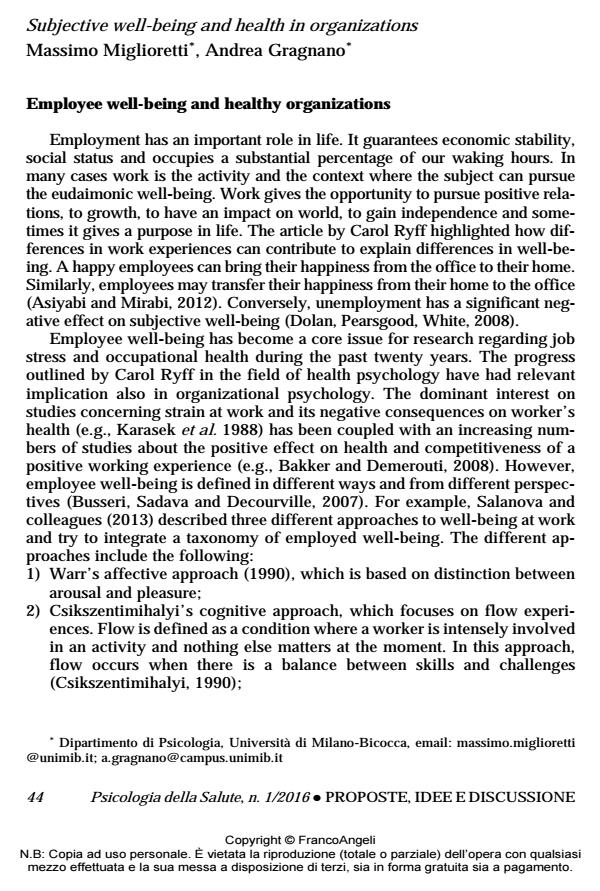Subjective well-being and health in organizations
Titolo Rivista PSICOLOGIA DELLA SALUTE
Autori/Curatori Massimo Miglioretti, Andrea Gragnano
Anno di pubblicazione 2016 Fascicolo 2016/1 Lingua Inglese
Numero pagine 5 P. 44-48 Dimensione file 37 KB
DOI 10.3280/PDS2016-001006
Il DOI è il codice a barre della proprietà intellettuale: per saperne di più
clicca qui
Qui sotto puoi vedere in anteprima la prima pagina di questo articolo.
Se questo articolo ti interessa, lo puoi acquistare (e scaricare in formato pdf) seguendo le facili indicazioni per acquistare il download credit. Acquista Download Credits per scaricare questo Articolo in formato PDF

FrancoAngeli è membro della Publishers International Linking Association, Inc (PILA)associazione indipendente e non profit per facilitare (attraverso i servizi tecnologici implementati da CrossRef.org) l’accesso degli studiosi ai contenuti digitali nelle pubblicazioni professionali e scientifiche
- Anderson P., Jané-Llopis E. and Cooper C. (2011). The imperative of well-being. Stress and Health, 27: 353-355. DOI: 10.1002/smi.1433
- Asiyabi M. and Mirabi V. (2012). Investigation of contributing factors in employee desertion in power engineering consultants (Moshanir) company. Interdisciplinary Journal of Contemporary Research in Business, 4(6): 1183-1199.
- Bakker A. B. (2015). Towards a multilevel approach of employee well-being. European Journal of Work and Organizational Psychology, 24: 839-843. DOI: 10.1080/1359432X.2015.1071423
- Bakker A. B., Demerouti E. (2008). Towards a model of work engagement. Career Development International, 13: 209-223. DOI: 10.1108/13620430810870476
- Busseri M. A., Sadava S. W. and Decourville N. (2007). A hybrid model for research on subjective well-being: Examining common- and component-specific sources of variance in life satisfaction, positive affect and negative affect. Social Indicators Research, 83: 413-445. DOI: 10.1007/s11205-006-9028-8
- Csikszentmihalyi M. (1990). Flow: The psychology of optimal experience. New York: Harper and Row.
- Dolan P., Pearsgood T. and White M. (2008). Do we really know makes up happy? A review of the economic literature on the factors associated with subjective well-being. Journal of Economic Psychology, 29: 94-122. DOI: 10.1016/j.joep.2007.09.001
- EUROSTAT (2011). hlth_dlm040 - Population by type of disability, sex, age and labour status [Table]. Retrived from http://ec.europa.eu/eurostat/web/health/disability/data/database.
- Faragher E. B., Cass M. and Cooper C. L. (2005). The relationship between job satisfaction and health: a meta analysis. Occupational and Environmental Medicine, 62: 105-112.
- Gillet N., Fouquereau E., Forest J., Brunault P. and Colombat P. (2012). The impact of organizational factors on psychological needs and their relations with well-being. Journal of Business Psychology, 27: 437-450. DOI: 10.1007/s10869-011-9253-2
- González-Romá V., Schaufeli W. B., Bakker A. and Lloret S. (2006). Burnout and work engagement: Independent or opposite poles? Journal of Vocational Behavior, 68: 165-174. DOI: 10.1016/j.jvb.2005.01.003
- Grabovac I. and Mustajbegovic J. (2015). Healthy occupational culture for worker-friendly workplace. Arh Hig Rada Toksikol, 66: 1-8. DOI: 10.1515/aibt-2015-66-2558
- Gragnano A., Miglioretti M., Frings-Dresen M. H. W. and De Boer A. G. E. M. (submitted). Development and validation of a new instrument measuring the key factors in the adjustment between work demands and health needs, the Work-Health Balance questionnaire.
- Karasek R. A., Theorell T., Schwartz J. E., Schnall P. L., Pieper C. F. and Michela J. L. (1988). Job characteristics in relation to the prevalence of myocardial infarction in the US Health Examination Survey (HES) and the Health and Nutrition Examination Survey (HANES). American Journal of Public Health, 78: 910-918.
- Kuykendall L. and Tay L. (2015). Employee subjective well-being and physiological functioning: an integrative model. Health Psychology Open, 1-11. DOI: 10.1177/2055102915592090
- Ilies R., Aw S. S. Y. and Pluut H. (2015). Intraindividual models of employee well-being: what have we learned and where do we go from here? European Journal of Work and Organizational Psychology, 24: 827-838. DOI: 10.1080/1359432X.2015.1071422
- Nacamulli R. C. D., Ghiringhelli C., Lazazzara A., Quacquarelli B. and Prus I. (2015). La gestione delle risorse umane in Italia. Report dei risultati della ricerca Cranet 2015. BTDC Reserch Report, Milano.
- Quick J. C., Macik-Frey M. and Cooper C. L. (2007). Managerial Dimensions of Organizational Health: the healthy leader at work. Journal of Management Study, 44, 189-205. DOI: 10.1111/j.1467-6486.2007.00684.x
- Salanova M., Del Libano M., Llorens S. and Schaufeli W. B. (2013). Engaged, Workaholic Burned-out of just 9 to 5? Toward a typology of employee well-beng. Stress & Health, 30: 71-81. DOI: 10.1002/smi.2499
- Stuckler D., Basu S., Suhrcke M., Coutts A. and McKee M. (2011). Effects of the 2008 recession on health: a first look at European data. Lancet, 378: 124-125. DOI: 10.1016/S0140-6736(11)61079-9
- .Warr P. (1990). The measure of well-being and other aspects of mental health. Journal of Personality and Social Psychology, 44: 644-651. DOI: 10.1111/j.2044-8325.1990.tb00521.x
- Cognitive and affective-motivational states as mediators of the association between presenteeism and job satisfaction José-María Figueredo, Cristina García-Ael, Andrea Gragnano, Gabriela Topa, in European Review of Applied Psychology 100865/2023 pp.100865
DOI: 10.1016/j.erap.2022.100865 - Work–Life Balance: Weighing the Importance of Work–Family and Work–Health Balance Andrea Gragnano, Silvia Simbula, Massimo Miglioretti, in International Journal of Environmental Research and Public Health /2020 pp.907
DOI: 10.3390/ijerph17030907
Massimo Miglioretti, Andrea Gragnano, Subjective well-being and health in organizations in "PSICOLOGIA DELLA SALUTE" 1/2016, pp 44-48, DOI: 10.3280/PDS2016-001006